UNIV 1212: Critical Thinking and Problem Solving Evidence Report
VerifiedAdded on 2021/11/23
|5
|1310
|89
Report
AI Summary
This report analyzes Chapter 5, "The Use of Evidence," from a critical thinking and problem-solving textbook for UNIV 1212. The report emphasizes the importance of evidence in argumentation, critical thinking, and communication. It discusses key concepts such as the nature of evidence (factual and opinion-based), evaluation criteria (reliability, expertise, objectivity, consistency, recency, and relevance), the assessment of statistical evidence, and the presentation of evidence. The analysis highlights how evidence supports decision-making, strengthens arguments, and improves communication clarity. The report concludes by underscoring the significance of using strong evidence to persuade and convince others, thereby enhancing critical thinking and problem-solving abilities. The student report is a valuable resource for students seeking to understand and apply the principles of effective argumentation and evidence-based reasoning.
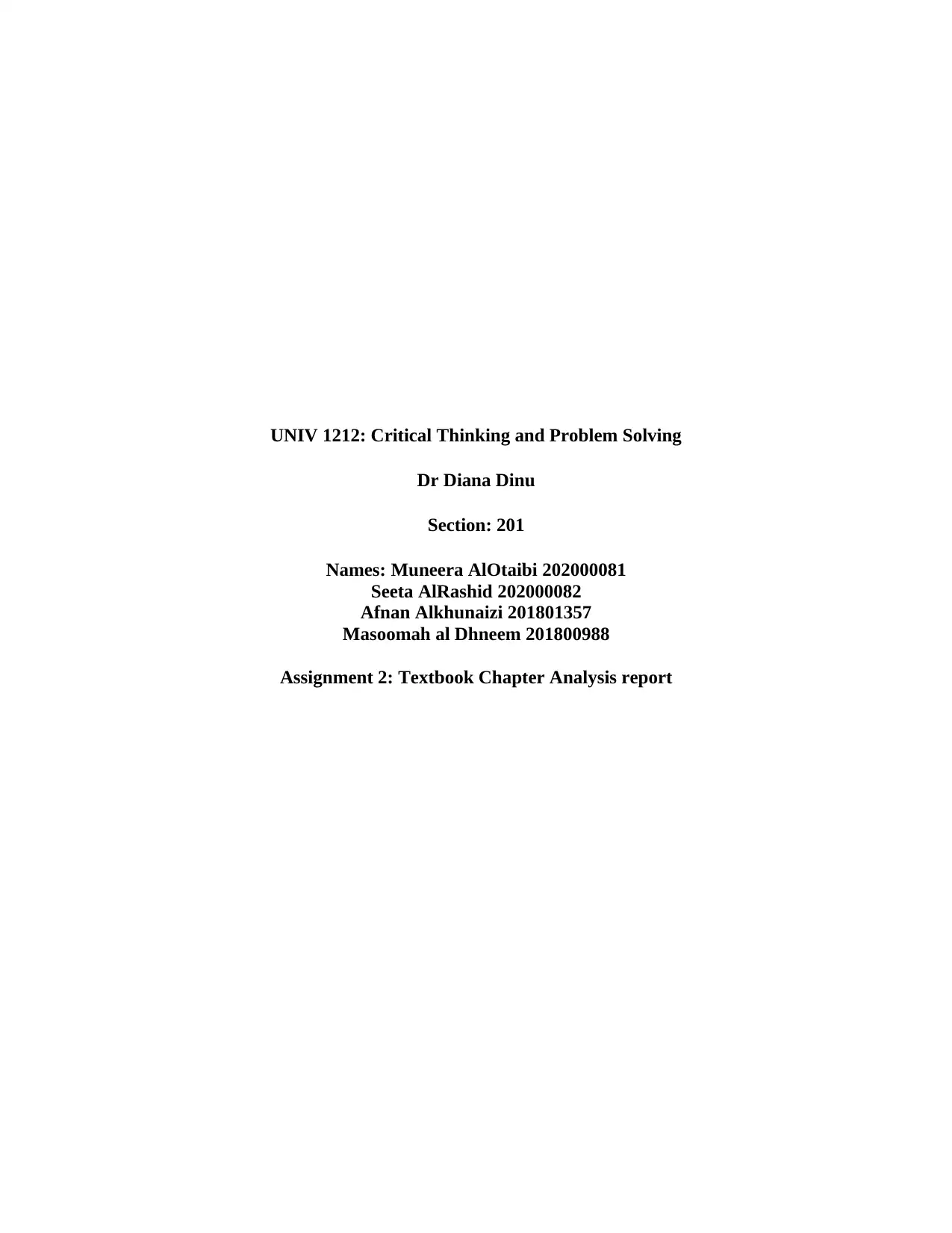
UNIV 1212: Critical Thinking and Problem Solving
Dr Diana Dinu
Section: 201
Names: Muneera AlOtaibi 202000081
Seeta AlRashid 202000082
Afnan Alkhunaizi 201801357
Masoomah al Dhneem 201800988
Assignment 2: Textbook Chapter Analysis report
Dr Diana Dinu
Section: 201
Names: Muneera AlOtaibi 202000081
Seeta AlRashid 202000082
Afnan Alkhunaizi 201801357
Masoomah al Dhneem 201800988
Assignment 2: Textbook Chapter Analysis report
Paraphrase This Document
Need a fresh take? Get an instant paraphrase of this document with our AI Paraphraser
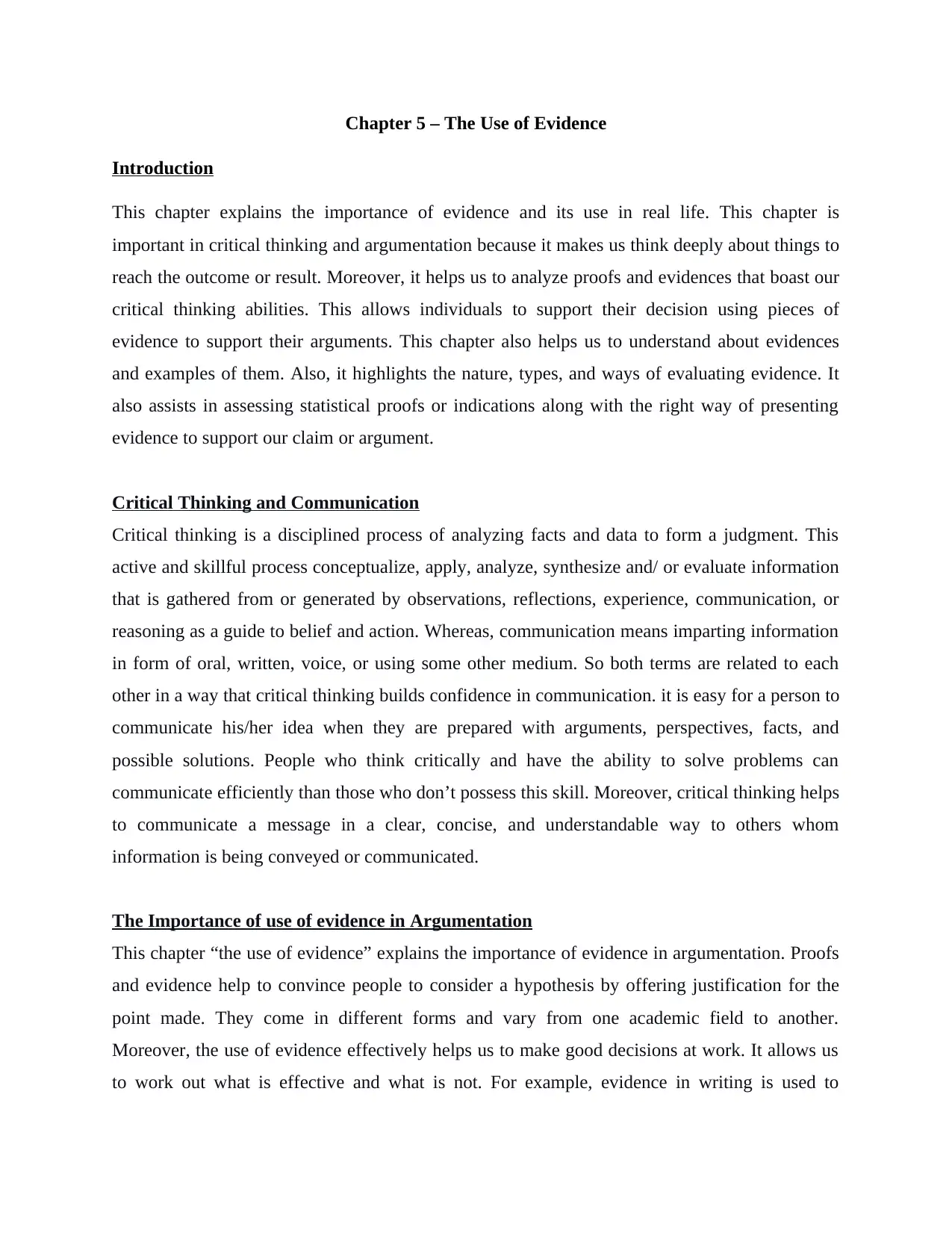
Chapter 5 – The Use of Evidence
Introduction
This chapter explains the importance of evidence and its use in real life. This chapter is
important in critical thinking and argumentation because it makes us think deeply about things to
reach the outcome or result. Moreover, it helps us to analyze proofs and evidences that boast our
critical thinking abilities. This allows individuals to support their decision using pieces of
evidence to support their arguments. This chapter also helps us to understand about evidences
and examples of them. Also, it highlights the nature, types, and ways of evaluating evidence. It
also assists in assessing statistical proofs or indications along with the right way of presenting
evidence to support our claim or argument.
Critical Thinking and Communication
Critical thinking is a disciplined process of analyzing facts and data to form a judgment. This
active and skillful process conceptualize, apply, analyze, synthesize and/ or evaluate information
that is gathered from or generated by observations, reflections, experience, communication, or
reasoning as a guide to belief and action. Whereas, communication means imparting information
in form of oral, written, voice, or using some other medium. So both terms are related to each
other in a way that critical thinking builds confidence in communication. it is easy for a person to
communicate his/her idea when they are prepared with arguments, perspectives, facts, and
possible solutions. People who think critically and have the ability to solve problems can
communicate efficiently than those who don’t possess this skill. Moreover, critical thinking helps
to communicate a message in a clear, concise, and understandable way to others whom
information is being conveyed or communicated.
The Importance of use of evidence in Argumentation
This chapter “the use of evidence” explains the importance of evidence in argumentation. Proofs
and evidence help to convince people to consider a hypothesis by offering justification for the
point made. They come in different forms and vary from one academic field to another.
Moreover, the use of evidence effectively helps us to make good decisions at work. It allows us
to work out what is effective and what is not. For example, evidence in writing is used to
Introduction
This chapter explains the importance of evidence and its use in real life. This chapter is
important in critical thinking and argumentation because it makes us think deeply about things to
reach the outcome or result. Moreover, it helps us to analyze proofs and evidences that boast our
critical thinking abilities. This allows individuals to support their decision using pieces of
evidence to support their arguments. This chapter also helps us to understand about evidences
and examples of them. Also, it highlights the nature, types, and ways of evaluating evidence. It
also assists in assessing statistical proofs or indications along with the right way of presenting
evidence to support our claim or argument.
Critical Thinking and Communication
Critical thinking is a disciplined process of analyzing facts and data to form a judgment. This
active and skillful process conceptualize, apply, analyze, synthesize and/ or evaluate information
that is gathered from or generated by observations, reflections, experience, communication, or
reasoning as a guide to belief and action. Whereas, communication means imparting information
in form of oral, written, voice, or using some other medium. So both terms are related to each
other in a way that critical thinking builds confidence in communication. it is easy for a person to
communicate his/her idea when they are prepared with arguments, perspectives, facts, and
possible solutions. People who think critically and have the ability to solve problems can
communicate efficiently than those who don’t possess this skill. Moreover, critical thinking helps
to communicate a message in a clear, concise, and understandable way to others whom
information is being conveyed or communicated.
The Importance of use of evidence in Argumentation
This chapter “the use of evidence” explains the importance of evidence in argumentation. Proofs
and evidence help to convince people to consider a hypothesis by offering justification for the
point made. They come in different forms and vary from one academic field to another.
Moreover, the use of evidence effectively helps us to make good decisions at work. It allows us
to work out what is effective and what is not. For example, evidence in writing is used to
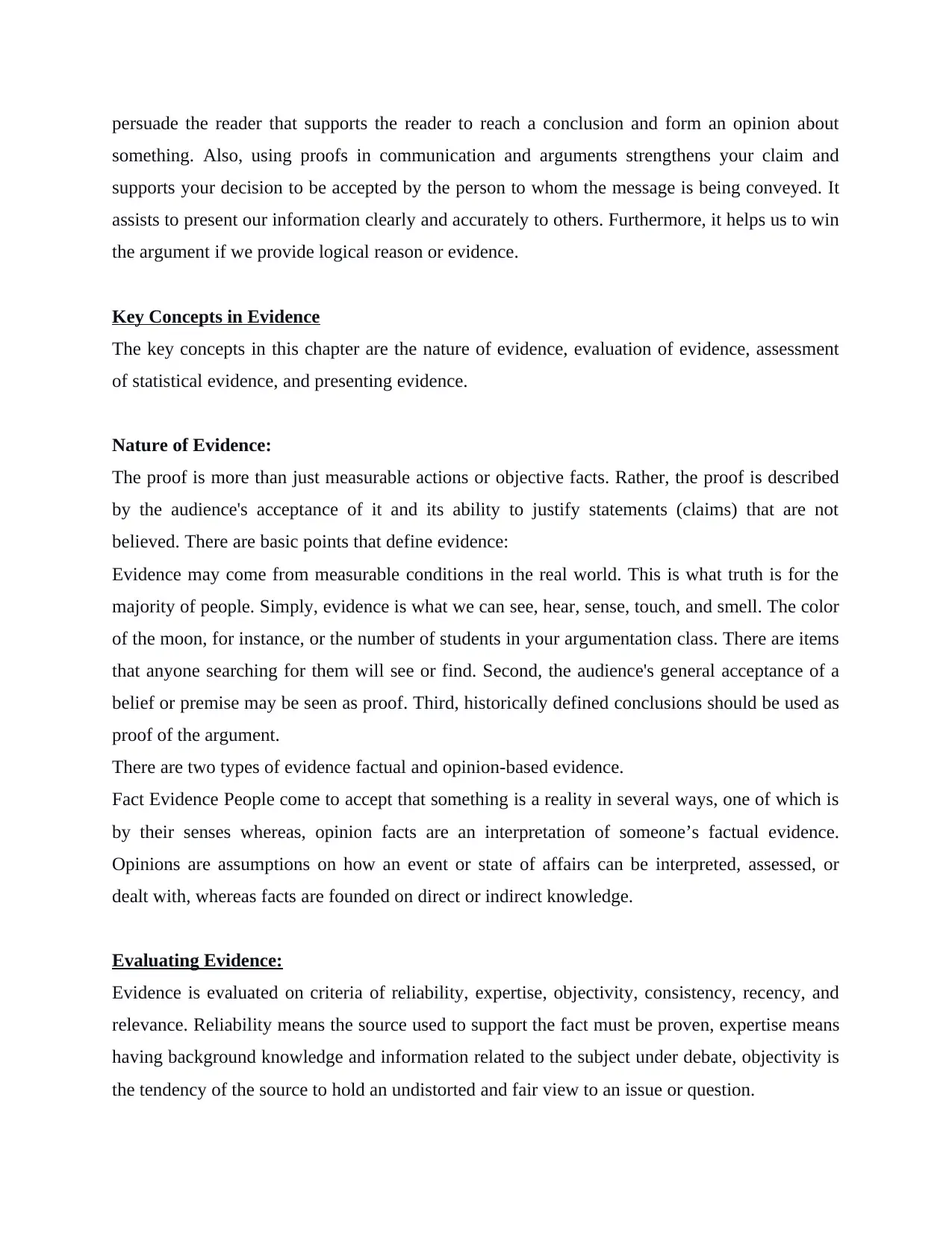
persuade the reader that supports the reader to reach a conclusion and form an opinion about
something. Also, using proofs in communication and arguments strengthens your claim and
supports your decision to be accepted by the person to whom the message is being conveyed. It
assists to present our information clearly and accurately to others. Furthermore, it helps us to win
the argument if we provide logical reason or evidence.
Key Concepts in Evidence
The key concepts in this chapter are the nature of evidence, evaluation of evidence, assessment
of statistical evidence, and presenting evidence.
Nature of Evidence:
The proof is more than just measurable actions or objective facts. Rather, the proof is described
by the audience's acceptance of it and its ability to justify statements (claims) that are not
believed. There are basic points that define evidence:
Evidence may come from measurable conditions in the real world. This is what truth is for the
majority of people. Simply, evidence is what we can see, hear, sense, touch, and smell. The color
of the moon, for instance, or the number of students in your argumentation class. There are items
that anyone searching for them will see or find. Second, the audience's general acceptance of a
belief or premise may be seen as proof. Third, historically defined conclusions should be used as
proof of the argument.
There are two types of evidence factual and opinion-based evidence.
Fact Evidence People come to accept that something is a reality in several ways, one of which is
by their senses whereas, opinion facts are an interpretation of someone’s factual evidence.
Opinions are assumptions on how an event or state of affairs can be interpreted, assessed, or
dealt with, whereas facts are founded on direct or indirect knowledge.
Evaluating Evidence:
Evidence is evaluated on criteria of reliability, expertise, objectivity, consistency, recency, and
relevance. Reliability means the source used to support the fact must be proven, expertise means
having background knowledge and information related to the subject under debate, objectivity is
the tendency of the source to hold an undistorted and fair view to an issue or question.
something. Also, using proofs in communication and arguments strengthens your claim and
supports your decision to be accepted by the person to whom the message is being conveyed. It
assists to present our information clearly and accurately to others. Furthermore, it helps us to win
the argument if we provide logical reason or evidence.
Key Concepts in Evidence
The key concepts in this chapter are the nature of evidence, evaluation of evidence, assessment
of statistical evidence, and presenting evidence.
Nature of Evidence:
The proof is more than just measurable actions or objective facts. Rather, the proof is described
by the audience's acceptance of it and its ability to justify statements (claims) that are not
believed. There are basic points that define evidence:
Evidence may come from measurable conditions in the real world. This is what truth is for the
majority of people. Simply, evidence is what we can see, hear, sense, touch, and smell. The color
of the moon, for instance, or the number of students in your argumentation class. There are items
that anyone searching for them will see or find. Second, the audience's general acceptance of a
belief or premise may be seen as proof. Third, historically defined conclusions should be used as
proof of the argument.
There are two types of evidence factual and opinion-based evidence.
Fact Evidence People come to accept that something is a reality in several ways, one of which is
by their senses whereas, opinion facts are an interpretation of someone’s factual evidence.
Opinions are assumptions on how an event or state of affairs can be interpreted, assessed, or
dealt with, whereas facts are founded on direct or indirect knowledge.
Evaluating Evidence:
Evidence is evaluated on criteria of reliability, expertise, objectivity, consistency, recency, and
relevance. Reliability means the source used to support the fact must be proven, expertise means
having background knowledge and information related to the subject under debate, objectivity is
the tendency of the source to hold an undistorted and fair view to an issue or question.
⊘ This is a preview!⊘
Do you want full access?
Subscribe today to unlock all pages.

Trusted by 1+ million students worldwide
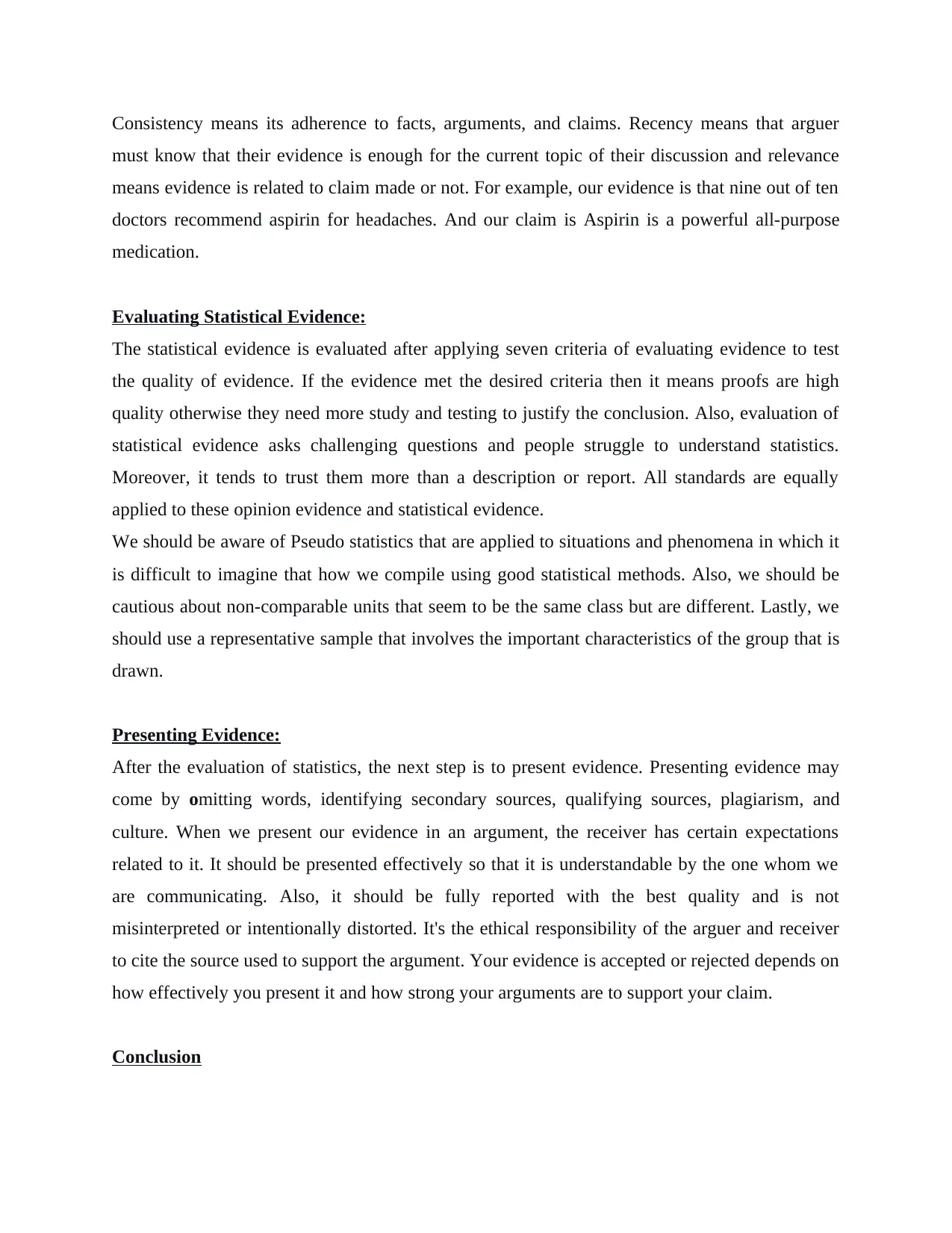
Consistency means its adherence to facts, arguments, and claims. Recency means that arguer
must know that their evidence is enough for the current topic of their discussion and relevance
means evidence is related to claim made or not. For example, our evidence is that nine out of ten
doctors recommend aspirin for headaches. And our claim is Aspirin is a powerful all-purpose
medication.
Evaluating Statistical Evidence:
The statistical evidence is evaluated after applying seven criteria of evaluating evidence to test
the quality of evidence. If the evidence met the desired criteria then it means proofs are high
quality otherwise they need more study and testing to justify the conclusion. Also, evaluation of
statistical evidence asks challenging questions and people struggle to understand statistics.
Moreover, it tends to trust them more than a description or report. All standards are equally
applied to these opinion evidence and statistical evidence.
We should be aware of Pseudo statistics that are applied to situations and phenomena in which it
is difficult to imagine that how we compile using good statistical methods. Also, we should be
cautious about non-comparable units that seem to be the same class but are different. Lastly, we
should use a representative sample that involves the important characteristics of the group that is
drawn.
Presenting Evidence:
After the evaluation of statistics, the next step is to present evidence. Presenting evidence may
come by omitting words, identifying secondary sources, qualifying sources, plagiarism, and
culture. When we present our evidence in an argument, the receiver has certain expectations
related to it. It should be presented effectively so that it is understandable by the one whom we
are communicating. Also, it should be fully reported with the best quality and is not
misinterpreted or intentionally distorted. It's the ethical responsibility of the arguer and receiver
to cite the source used to support the argument. Your evidence is accepted or rejected depends on
how effectively you present it and how strong your arguments are to support your claim.
Conclusion
must know that their evidence is enough for the current topic of their discussion and relevance
means evidence is related to claim made or not. For example, our evidence is that nine out of ten
doctors recommend aspirin for headaches. And our claim is Aspirin is a powerful all-purpose
medication.
Evaluating Statistical Evidence:
The statistical evidence is evaluated after applying seven criteria of evaluating evidence to test
the quality of evidence. If the evidence met the desired criteria then it means proofs are high
quality otherwise they need more study and testing to justify the conclusion. Also, evaluation of
statistical evidence asks challenging questions and people struggle to understand statistics.
Moreover, it tends to trust them more than a description or report. All standards are equally
applied to these opinion evidence and statistical evidence.
We should be aware of Pseudo statistics that are applied to situations and phenomena in which it
is difficult to imagine that how we compile using good statistical methods. Also, we should be
cautious about non-comparable units that seem to be the same class but are different. Lastly, we
should use a representative sample that involves the important characteristics of the group that is
drawn.
Presenting Evidence:
After the evaluation of statistics, the next step is to present evidence. Presenting evidence may
come by omitting words, identifying secondary sources, qualifying sources, plagiarism, and
culture. When we present our evidence in an argument, the receiver has certain expectations
related to it. It should be presented effectively so that it is understandable by the one whom we
are communicating. Also, it should be fully reported with the best quality and is not
misinterpreted or intentionally distorted. It's the ethical responsibility of the arguer and receiver
to cite the source used to support the argument. Your evidence is accepted or rejected depends on
how effectively you present it and how strong your arguments are to support your claim.
Conclusion
Paraphrase This Document
Need a fresh take? Get an instant paraphrase of this document with our AI Paraphraser
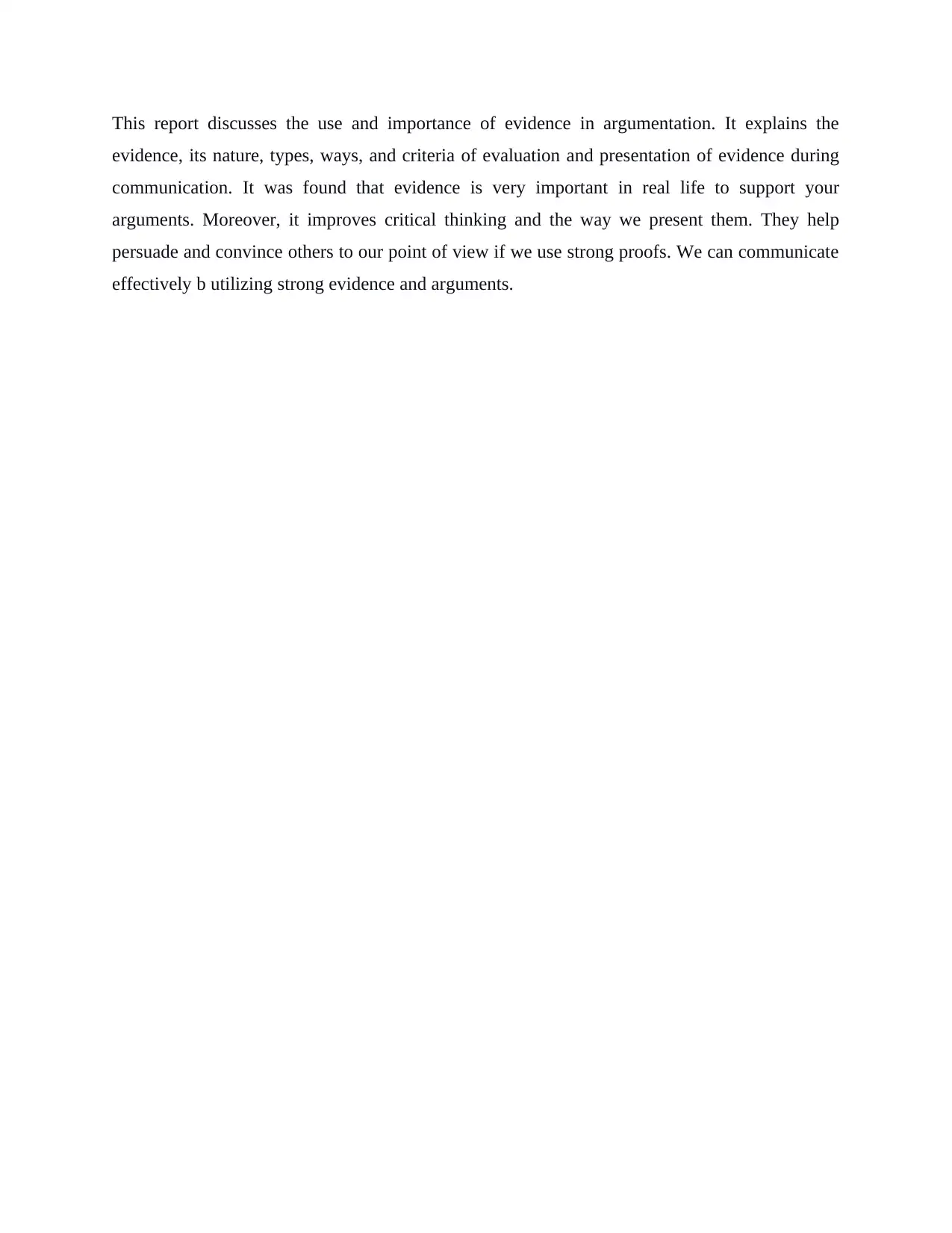
This report discusses the use and importance of evidence in argumentation. It explains the
evidence, its nature, types, ways, and criteria of evaluation and presentation of evidence during
communication. It was found that evidence is very important in real life to support your
arguments. Moreover, it improves critical thinking and the way we present them. They help
persuade and convince others to our point of view if we use strong proofs. We can communicate
effectively b utilizing strong evidence and arguments.
evidence, its nature, types, ways, and criteria of evaluation and presentation of evidence during
communication. It was found that evidence is very important in real life to support your
arguments. Moreover, it improves critical thinking and the way we present them. They help
persuade and convince others to our point of view if we use strong proofs. We can communicate
effectively b utilizing strong evidence and arguments.
1 out of 5
Related Documents
Your All-in-One AI-Powered Toolkit for Academic Success.
+13062052269
info@desklib.com
Available 24*7 on WhatsApp / Email
![[object Object]](/_next/static/media/star-bottom.7253800d.svg)
Unlock your academic potential
Copyright © 2020–2025 A2Z Services. All Rights Reserved. Developed and managed by ZUCOL.



